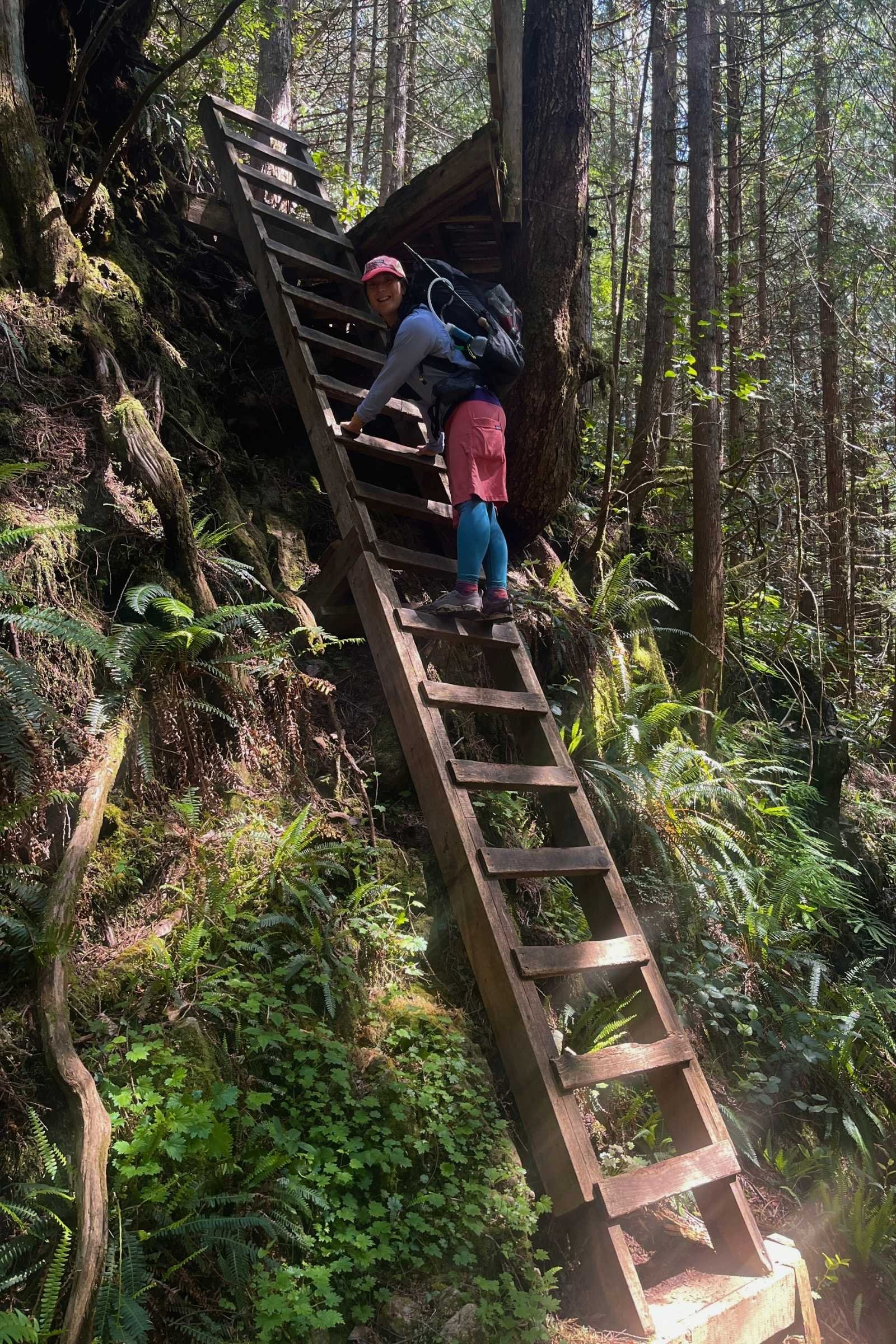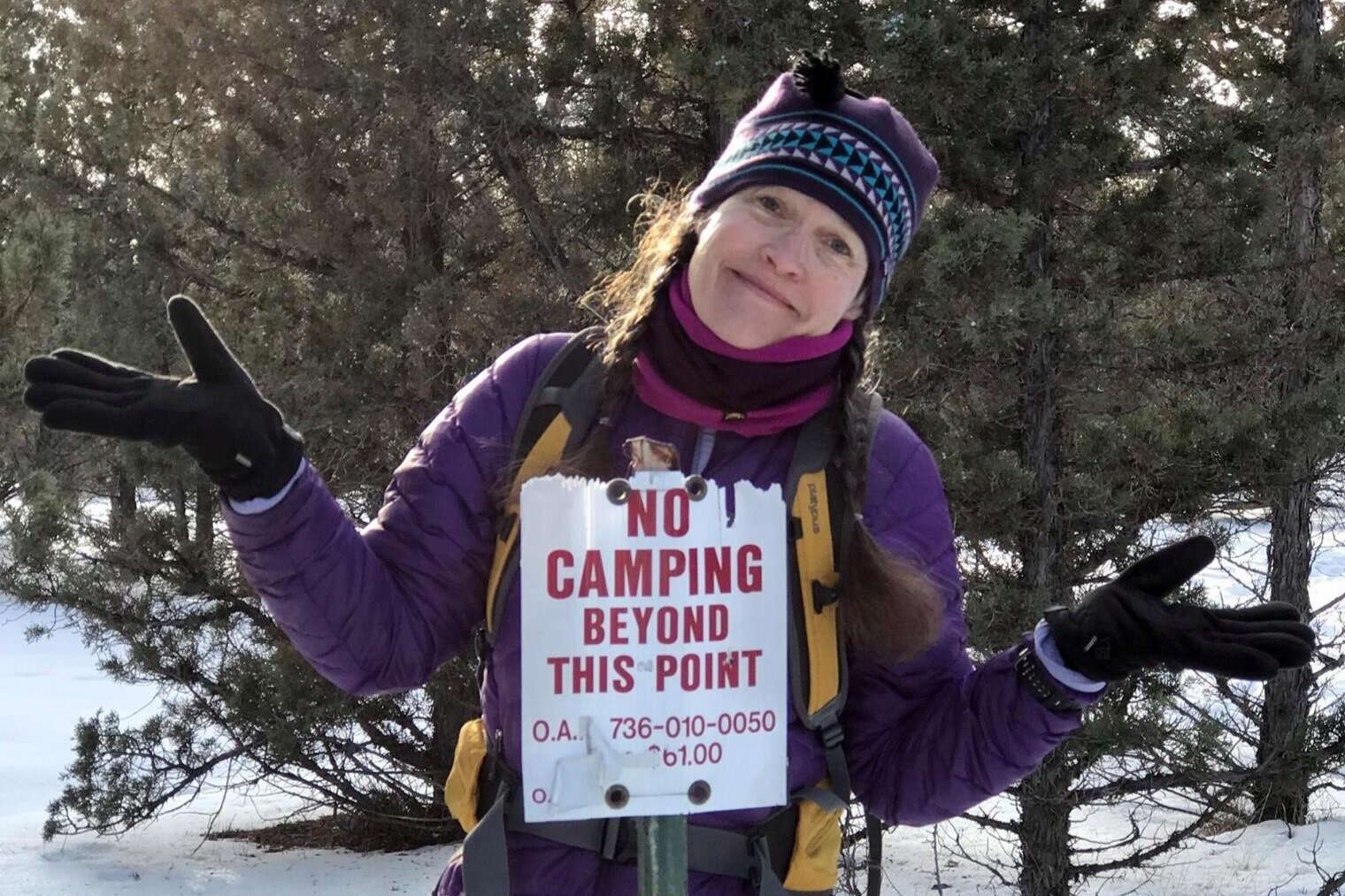Liz is back from thru-hiking the West Coast Trail in Canada
Favorite gear, tips on entering Canada, and travel logistics
Liz is back from thru-hiking the West Coast Trail in Canada. Here are her gear highlights and logistic hacks from the trip.
The West Coast Trail in British Columbia is a 76km (~47 miles) thru-hike on Vancouver Island. It is famous for old growth trees, fresh seafood, rugged tide-pool filled beaches, sea stacks and holes in rocks timed with tides, dozens of ladders to bluffs, and human-powered cable cars across rivers.
We create reader-supported, objective gear reviews independently selected by our editors. This story may contain affiliate links, which help fund our website. When you click on the links to purchase gear, we may get a commission — without costing you an extra cent. Thank you for supporting our work and mission of outdoor coverage for every body! Learn more.
Why I loved the West Coast Trail
The West Coast Trail (WCT) is so remote with no road crossings to remind you of an outside world, meaning you can really concentrate on just being on the trail.
One of my favorite things about the West Coast Trail is I felt really connected to the history of the trail--from the First Nations who first used the trail and still call it home and their workplace today, to its history as a rescue path for shipwreck survivors with actual shipwrecks you can see from the trail.
Despite this rugged history, the infrastructure along the trail felt like the right amount: ladders to get around impassable sea bluffs, cable cars to get across un-fordable rivers, even bear boxes so I didn’t have to carry a bear can. But, in my opinion, it didn’t feel too built up. The trail was still muddy, bog boards were out, and occasionally a ladder was missing a rung. It felt like a full-body adventure. It reminded me a lot of the Long Trail or Appalachian Trail, except with fewer people, more views, lots of time on the beach, and way more remote.
New Gear I tested on the West Coast Trail
Mountain Hardwear Sunshield sun hoodie: Comes with a lightweight, woven fabric that has UVA and UVB protection. I actually got sunburnt hanging out on the beach on this trail, so sun protection was appreciated! I’m testing it for our Best Sun Shirts guide.
Mountain Hardwear Sunshield sun hoodie
Men's
Women's
Altra Lone Peak 9: The non-Vibram version of the Altra Lone Peak 9+ we reviewed and love. I wanted to save $10 and test whether Altra’s house brand of outsole rubber would be good enough for a trail as rugged as the WCT. It delivered!
Altra Lone Peak 9
Men's
Women's
Astral NOSOBO: The new wide-toebox, zero drop hiking shoe designed to last more than 1,000 miles, the Astral SOBO famously has a replaceable midsole. For most hiking shoes, the midsole is the first part to go, requiring you to replace the shoe. With the SOBO, as long as your shoe is free of holes, you can switch out the midsole and use the same shoe. I tested it for our Best Women’s Hiking Shoes guide.
Astral NOSOBO
Favorite gear from the West Coast Trail
Jetboil Flash 1.0L: The new Jetboil is rad! The WCT was chilly and I found myself boiling water four times a day. My mileage each day was relatively low so I had time to drink a second cup of coffee, eat a hot lunch, and have a cup of tea after dinner. Jetboil took every pain out of a backpacking stove. The new switch and ignitor is so easy to use, the temperature indicator lets me know when it is boiled, and the pot and base detach and reattach smoothly. It’s our winner for Easiest to Use in our Best Backpacking Stoves guide and this trip re-affirmed its position.
Jetboil Flash 1.0L
Granite Gear Crown3 60L: We’ve written extensively about the Crown3 60. It won Best Budget in our Best Lightweight Backpacking Backpacks guide and even snagged a spot in our Favorite Gear of 2024 article. After my hiking partner tested five different packs in prep for this trail, the Crown3 60 fit the best and was the most comfortable. Other hikers laughed that he used a white-colored pack on such a muddy trail (to clarify: it’s actually un-dyed to be more eco-friendly). Yet the comfort was unparalleled for long climbs up and down ladders. Still, if we were to do it again, maybe we'd go with a less mud-showing brown.
Granite Gear Crown3 60L
Men's
Women's
The WCT is misty, foggy and right on the beach. My windbreaker was the all-star piece of gear apparel. I found myself wearing this more than any other gear. See our Best Men’s Windbreakers and Best Women’s Windbreakers guides for ones we recommend.
Tips for Canadian Customs and Immigration
Treeline Review’s West Coast Trail guide was written by Treeline Review writer Sonja Lind, who has Canadian citizenship and also used ground transit to get to the West Coast Trail. As a U.S. citizen entering Canada by plane, I’ll share my experience with customs and immigration so you can plan accordingly on what you bring.
U.S. citizens will not need a separate visa to enter Canada. However, like all people entering Canada including Canadian citizens, you will need to fill out a customs form and talk with an agent.
Customs may ask if you have a weapon. They specifically asked me about a knife. I had a 1” long Gossamer Gear pocket knife and they said that counts as a weapon I need to declare.
Don’t bring pepper spray, as this is considered an illegal weapon to bring across borders. Bear spray may be allowed if you drive or ferry to Vancouver Island, but you usually can’t take it on a flight.
Your customs and immigration form will ask a complicated question about whether you have any meat or fruit or seeds. I purposely ate all my fresh apple slices before entering Canada because I knew they’d ask about that. But apparently, that question refers to essentially all food items. I got pressed by the agent about the freeze-dried backpacking meals I brought. So, if you’re bringing backpacking food, be sure to declare it on the form.
Ground transit to get to-from the WCT
I struggle with logistics of getting to-and-from a trail so thought it’d be helpful to share here step-by-step logistics for the West Coast Trail.
How I got to the West Coast Trail:
Flew into Victoria, BC (layover in Seattle)
Took the public bus ($6 Canadian) to a close-by transit stop, then transferred to the bus headed to downtown Victoria
Stayed the night at the Ocean’s Backpacker’s hostel (free breakfast, beverage, and dinner included)
Woke up early (it gets bright in Victoria at 4:30 a.m. so this wasn’t a problem) and walked with my gear down to the Victoria Bus Station
Hopped on the West Coast Trail Bus at 6:30 a.m. (reservations made ahead of time). I also gave the bus company my non-hiking gear to hold while I was on trail, including fresh changes of clothes and my laptop.
They dropped me off at the Parks Canada Permit Office, where I listened to the mandatory orientation.
The warden walked me over to the ferry that dropped me off at the southern terminus.
Here’s how I got back from the West Coast Trail:
A human-powered cable car that hikers use to pull themselves over wide and deep rivers along the trail.
I checked out of the WCT at the warden’s office at the northern terminus.
I walked the short distance to the bus stop (very important as the bus doesn’t stop directly at the Park’s Canada building).
Hopped on the West Coast Trail Bus to Victoria. This magical bus solves one of the biggest logistic challenges for WCT hikers. Our bus driver Brayton took us 7 hours over some of the worst bumpy dirt roads imaginable, radio-ing into headquarters when he reached checkpoints, and giving us adequate bathroom breaks. Dramamine recommended. The cost of this bus ticket was worth every dollar. Thanks, Brayton!
The West Coast Trail Bus dropped me off in downtown Victoria and I walked back to the Ocean Backpacker’s Hostel.
Ubered from the hostel to the Victoria airport (could have taken the bus but it was an early flight).
Final thoughts and advice for the WCT
The West Coast Trail was one of the coolest thru-hikes I’ve been on, packing a lot of living into such a short trail. It’s been on my bucket list for years and I’m glad I finally did it!
However, I’m glad I waited to hike this trail until I was past my dirtbag thru-hiker years. Like many international hikes, it’s an expensive trail compared to U.S. thru-hikes. Permits for the trail, permits for the park, and shuttle bus rides add up.
As a younger hiker, I would’ve been bitter about the cost, especially since the trail is so short. I also would have been too cheap to pay for the fresh crab and fish at the halfway point, which ended up being one of those new life experiences that make this trail unforgettable. Instead, I treated each kilometer as if it was the distance of a mile and then some and felt like I milked the best out of every inch (or should I say centimeter?) of that trail.
I think it’d totally be possible for young, broke thru-hikers to have a blast on this trail, too. I traveled alongside a friend group of six college students that went swimming at every campsite, built campfires every night, and always seemed to be joking around. They seemed to have the time of their life, too, even if they were only getting a $10 grilled cheese sandwich at the Crab Shack.
So ultimately, like most trails, whether you enjoy the WCT and think it is worth it comes down to attitude and what you bring to it. For me, it ranks among my top thru-hikes ever. . .and one I can’t wait to do again.
Why you should trust us
I’ve backpacked over 20,000 miles and have at least 1,000 nights sleeping outdoors. Many of those routes take me to sensitive areas where using a human waste bag and packing out human waste is essential.
For this article, I’ve also interviewed mountaineers, canyoneers, rafters, vanlifers, and climbers to hear about their experiences properly disposing human waste in the backcountry.
Treeline Review writers who raft, climb, and vanlife also lent a hand testing wag bags on their sport of choice.
I’ve written about outdoor gear for numerous publications, including as contributing editor at Backpacker Magazine and as a staff writer for the New York Times’ product review site, Wirecutter.
I’m the author of the National Outdoor Book Award winning Long Trails Mastering the Art of the Thru-hike. I regularly book speaking gigs with outdoor clubs, non-profits, and colleges and universities to talk about backpacking and lead gear panels. I’m also Editor-in-Chief here at Treeline Review and oversee all of our outdoor gear stories.
You can read more about me at www.eathomas.com or at my author page.




















